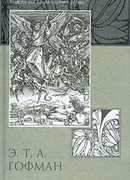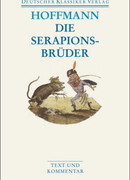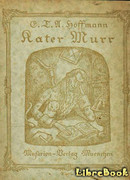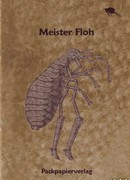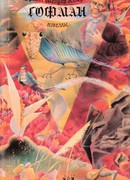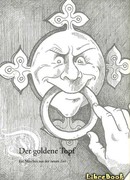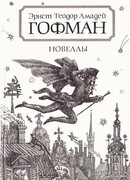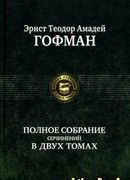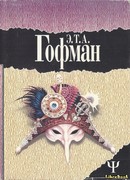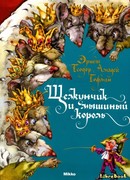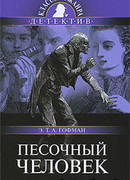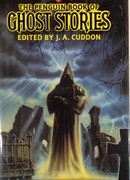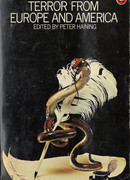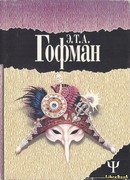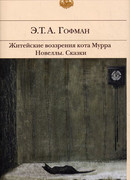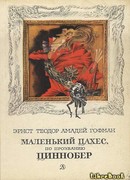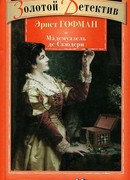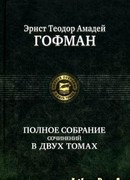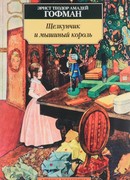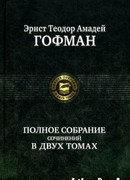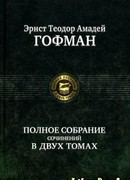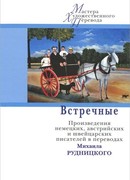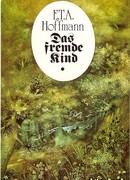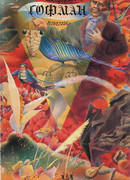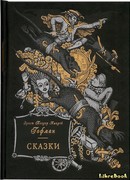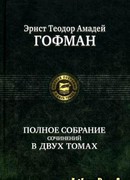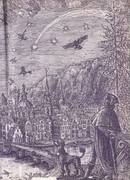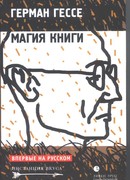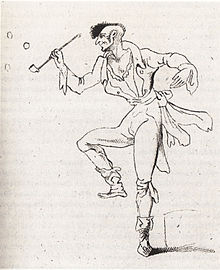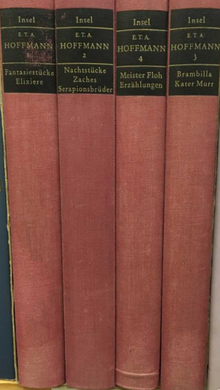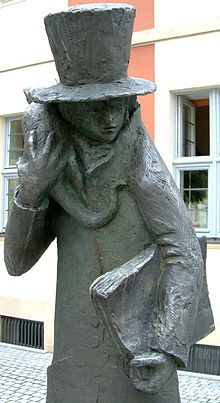Отзывы: 7
-
Очень хорошо помню сказку Гофмана «Щелкунчик и Мышиный король». У меня была дома большая книга с картинками, и мне казалось, что все персонажи этой сказки страшные и не приятные.
Ответить
-
Варвара
05.11.2020 в 15:06
Наверное классная сказки
Ответить
-
мишель
10.01.2021 в 10:53
Просто зачем писать в читательский дневник. смысла нет вообще.
Ответить
-
Наташа?
03.02.2021 в 20:05
А,трудно делать уроки,а ещё устаёшь,после школы,смысла нет!:(,????
Ответить
-
Светлана
07.01.2022 в 13:35
А в чем же, смысл, тогда, ребята?
Ответить
-
Лучше уехать в тайгу и жить там без школы
Ответить
Гофман: Сказки: читать онлайн популярные, лучшие народные сказки для детей, мальчиков и девочек, и их родителей о любви и Родине, природе, животных. Если вы не нашли желаемую сказку или тематику, рекомендуем воспользоваться поиском вверху сайта.
Автор
Эрнст Теодор Амадей Гофман
| Ernst Theodor Wilhelm Hoffmann
E. T. A. Hoffmann / Эрнст Теодор Вильгельм Гофман
Эрнст Теодор Амадей Гофман — немецкий писатель, композитор, художник. Псевдоним как композитора — Иоганн Крайслер.
Родился в семье прусского королевского адвоката Кристофа Людвига Гофмана (1736-1797). Когда Эрнсту было три года, его родители разошлись, и он воспитывался в доме бабушки по материнской линии под влиянием своего дяди-юриста, человека умного и талантливого, склонного к фантастике и мистике. Эрнст рано продемонстрировал способности к музыке и рисованию. Но, не без влияния дяди, он выбрал себе стезю юриспруденции, из которой всю свою последующую жизнь пытался вырваться и зарабатывать искусством.
В 1800 Гофман прекрасно окончил курс юридических наук в Кёнигсбергском университете и связал свою жизнь с государственной службой. В этом же году он покинул Кёнигсберг и до 1807 работал в разных чинах, в свободное время занимаясь музыкой и рисованием. Впоследствии попытки его зарабатывать на жизнь искусством приводили к бедности и бедствиям, лишь после 1813 дела его пошли лучше после получения небольшого наследства. Место капельмейстера в Дрездене ненадолго удовлетворило его профессиональные амбиции; после 1815 он потерял это место и принуждён был снова поступить на ненавистную службу, уже в Берлине. Однако новое место давало и заработок, и много времени для творчества.
Чувствуя отвращение к мещанским «чайным» обществам, Гофман проводил большую часть вечеров, а иногда и часть ночи, в винном погребке. Расстроив себе вином и бессонницей нервы, Гофман приходил домой и садился писать; ужасы, создаваемые его воображением, иногда приводили в страх его самого. А в узаконенный час Гофман уже сидел на службе и усердно работал.
Своё мировоззрение Гофман проводит в длинном ряду бесподобных в своём роде фантастических повестей и сказок. В них он искусно смешивает чудесное всех веков и народов с личным вымыслом, то мрачно-болезненным, то грациозно-весёлым. В ту пору немецкая критика была не очень высокого мнения о Гофмане; там предпочитали романтизм глубокомысленный и серьёзный, без примеси сарказма и сатиры. Гораздо популярнее Гофман был в других странах Европы и в Северной Америке; в России В. Г. Белинский назвал его «одним из величайших немецких поэтов, живописцем внутреннего мира», а Ф. М. Достоевский перечитал всего Гофмана по-русски и на языке оригинала.
В 46 лет от роду Гофман был окончательно истощён своим образом жизни; но и на смертном одре он сохранил силу воображения и остроумие. Умер в Берлине, похоронен на Иерусалимском кладбище.
(с) википедия
Редактировать описание
Пока ничего нет, Обсудить
Эрнст Теодор Амадей Гофман Автор, всего 27
Романы
Эликсир дьявола
The Devil’s Elixirs
психологический
мистика
ужасы
философский
фантастика
готика
религия
Видать, под несчастливой звездой родился Медард. Он – потомок проклятого Богом и людьми рода, происходящего от связи несчастного художника и Генуи и дьявольского создания, принявшего образ Св. Розалии. Над юношей довлеет родовое проклятие, несмотря на то, что он вырос в обители святой Липы, окончил духовную семинарию и принял монашеский постриг. Вскоре, Медард обнаружил в себе талант проповедника, способность влиять на слушателей. Но однажды, во время недомогания, ораторский дар изменяет Медарду. Чтобы восстановить реноме, юноша решается принять некое снадобье из кладовой монастыря, которым, по преданию, сатана искушал Св. Антония… ©MrsGonzo для LibreBook
10
Online
Серапионовы братья
The Serapion Brethren
мистика
реализм
ужасы
фантастика
готика
В феврале 1818 года в Берлине издательство Георга Раймера предложило собрать под одной обложкой раннее изданных, но разрозненных новел и сказок Гофмана. Гофман решил создать для них рамку из бесед группы друзей на манер «Декамерона» Джованни Боккаччо. Собрание друзей он назвал Серапионовыми братьями, в честь литературной группы, членом которой он являлся. В восьми встречах, друзья вымышленного романтического повествования, Оттмар, Теодор, Лотар, Киприан, Винценц и Сильвестр, рассказывают друг другу в общей сложности 28 рассказов (только 19 из них имеют названия), и обсуждают: насколько эти истории соответствуют Серапионовым принципам. ©MrsGonzo для LibreBook
39
Online
Житейские воззрения Кота Мурра
Lebensansichten des Katers Murr nebst fragmentarischer Biographie des Kapellmeisters Johannes Kreisler in zufälligen Makula
сатира
Мастер Абрагам Лисков, фокусник и чудотворец при дворе карманного княжества, во время устроенного им фантасмагорического праздненства спасает от утопления котенка. Мурр учится понимать язык рода двуногих, постигает грамоту и поглощает обрывки знаний из стариных фолиантов со стола маэстро, чтобы, наконец, поступить в услужение Иоганнесу Крейслеру и увековечить на бумаге свои наблюдения. Одареннейший из котов пером и чернилами излагает свою биографию и взгляды на мир, используя в качестве промокательной бумаги странички записей своего хозяина, благодаря чему мы кое-что узнаем и о жизни мятежного музыканта. Это философская сказка о столкновении двух миров: мира обывателей, прагматиков-рационалистов…
10
Online
Повелитель блох
Meister Floh
приключения
ирония
Кто же не мечтал о возможности читать мысли других? Как часто нам хочется заглянуть человеку в душу и узнать, о чем он думает на самом деле. Наш герой Перегринус Тис благодаря своему крошечному другу мастеру-блохе сможет читать мысли других. Но это оказывается таким утомительным занятием, что голова идет кругом от несоответствия мыслей и действий бесконечной вереницы людей. К тому же очень уж большое количество недоброжелателей, будучи не способными справиться с вожделением вторгнуться в голову собеседника, охотится за мудрым мастером-блохой. А может и не стоит читать мысли других, может это безнравственно покушаться на их думы в целях успокоить свое неугомонное сомнение? Только чистая пламенная…
9
Online
Повести, рассказы
Дон Жуан
Don Juan
философский
Новелла Э. Т. А. Гофмана, написанная в Бамберге в сентябре 1812 года, всего через несколько дней после разрыва автора с Юлией Марк, в которую он был безответно влюблён. Напечатана во «Всеобщей музыкальной газете» за 31 марта 1813 года и через год включена в сборник «Фантазии в манере Калло».
1
Online
Золотой горшок: сказка из новых времен
Der goldne Topf: Ein Märchen aus der neuen Zeit
ирония
В истории студента из Дрездена — Ансельма переплетаются реальность и вымысел, действующими лицами наряду с конректором Паульманом, надворной советницей, регистратором Геербрандом, голубоглазой Вероникой являются золотисто-зеленая змейка Серпентина, князь духов Фосфор, обитатель волшебной страны Атлантиды — Саламандр, архивариус Линдхорст. Действие сказки разворачивается то на улицах Дрездена, то у знаменитых Линковых купален, то в загадочном саду архивариуса, то в доме на Новом рынке, то в чудесном и таинственном царстве Атлантиды.
13
Online
Автомат
Die Automate
мистика
Рассказ «Автомат» входит в цикл «Серапионовы братья» (1819-1821). Цикл включает в себя произведения Гофмана, объединенные историей компании друзей, называвших себя «Серапионовы братья». В рассказах и повестях переплетается мистика и ужасы, необычные приключения и обычные истории. Влияние этого сборника на литературу XIX и XX века было очень велико – достаточно вспомнить кружок русских писателей «серебряного века». В городе появился автомат — деревянный говорящий турок, шепотом провозглашающий пророчества. И стар и млад толпами стекались люди к диковинному автомату…
1
Online
Фермата
Die Fermate
реализм
Рассказ «Фермата» входит в цикл «Серапионовы братья» (1819-1821). Цикл включает в себя произведения Гофмана, объединенные историей компании друзей, называвших себя «Серапионовы братья». В рассказах и повестях переплетается мистика и ужасы, необычные приключения и обычные истории. Влияние этого сборника на литературу XIX и XX века было очень велико – достаточно вспомнить кружок русских писателей «серебряного века». Картина Гуммеля «Компания в итальянском трактире» навеяла Эдуарду воспоминания, и он решает рассказать своему другу Теодору о двух сёстрах итальянках — Лауретте и Терезине — с которыми он был знаком много лет назад.
1
Online
Церковь иезуитов в Г.
Die Jesuiterkirche in G.
мистика
Новелла «Церковь иезуитов в Г.» входит в авторский сборник «Ночные истории». В нем объединены произведения, отражающие интерес Гофмана к «ночной стороне души», к подсознательному, иррациональному в человеческой психике. Гофмана привлекает тема безумия, преступления, таинственные, патологические душевные состояния. «Церковь иезуитов» принадлежит к характерному для романтической литературы жанру «новелл о художниках». Фабульная нить прерывается вторжением размышлений на эстетические темы. Они продолжают начатые в очерке «Жак Калло» раздумья Гофмана над проблемами искусства, всю жизнь занимавшими его. Речь идет об отношении искусства к жизни. Программный характер имеют слова мальтийца, обращенные…
2
Online
Щелкунчик и мышиный король
The Nutcracker and the Mouse King
приключения
мистика
философский
История Щелкунчика, написанная Гофманом в 1816 году, очаровывает и вдохновляет художников, композиторов, режиссеров, зрителей и читателей почти 200 лет. Эта история хранит новизну, потому что обращается к вере в чудо, которое живет в каждом из нас. Канун Рождества в доме Штальбаумов. Семилетняя Мари и ее старший брат Фриц с нетерпение ждут подарков, среди которых обнаруживается Щелкунчик. Попытавшись расколоть слишком большой орех, Фриц сломал игрушку. Мари, пожалев уродца, перевязывает его лентой и забирает в свою комнату. С боем часов Щелкунчик оживает, а из всех щелей начинают выбегать мыши… © MrsGonzo для LibreBook
14
Online
Песочный человек
The Sandman
мистика
«Песочный человек» (нем. Der Sandmann) — сказочная новелла немецкого романтика Гофмана, основанная на народных поверьях о песочном человеке. Открывает сборник рассказов «Ночные истории» (1817). Рассказ подаётся читателю как переписка нескольких лиц. Произведение начинается с трёх писем: Натаниэль — Лотару (Натаниэль рассказывает про случай, произошедший 30 октября, когда к нему пришёл продавец барометров, и про случай, произошедший в детстве, с Коппелиусом), Клара — Натаниэлю (Клара случайно прочитала первое письмо, высказывает свою точку зрения) и Натаниэль — Лотару (Натаниэль рассказывает про Спаланцани и Олимпию).
5
Online
Майорат
The Entail
мистика
готика
Молодой Теодор становится случайным гостем старого замка, мрачного и постепенно разрушающегося. На впечатлительного, романтически настроенного юношу это место оказывает тревожное и гнетущее впечатление. Тем более в первую же ночь происходит мистическое происшествие, из-за которого у него появляется уверенность, что здесь присутствует какая-то ужасная тайна. Действительно, барон, — владелец замка, — как будто избегает этого места, проводя большую часть времени в других поместьях, и только раз в год посещает на несколько недель своё родовое гнездо. За то небольшое время, которое он провёл здесь, впечатление Теодора о том, что то ли на замок наложено проклятие, то ли над его владельцами тяготеет…
1
Online
Советник Креспель
Rat Krespel
мистика
Рассказ «Советник Креспель» входит в цикл «Серапионовы братья» (1819-1821). Цикл включает в себя произведения Гофмана, объединенные историей компании друзей, называвших себя «Серапионовы братья». В рассказах и повестях переплетается мистика и ужасы, необычные приключения и обычные истории. Влияние этого сборника на литературу XIX и XX века было очень велико – достаточно вспомнить кружок русских писателей «серебряного века». Весь город Г. только и говорил о советнике Креспеле, ибо большего чудака и сумасброда не найти во всей округе!
1
Online
Пустой дом
Das öde Haus
мистика
ужасы
На одной из центральных улиц Берлина стоит пустующий дом. По официальной версии этот дом принадлежит кондитеру, который держит лавку в соседнем доме. Но про дом также ходят слухи, что с ним что-то нечисто, и в нём люди иногда слышат голоса, а в окнах порой заметно какое-то движение… © georgkorg
1
Online
Мастер Мартин-бочар и его подмастерья
Meister Martin der Küfner und seine Gesellen
реализм
Повесть «Мастер Мартин-бочар и его подмастерья» входит в цикл «Серапионовы братья» (1819-1821). Цикл включает в себя произведения Гофмана, объединенные историей компании друзей, называвших себя «Серапионовы братья». В рассказах и повестях переплетается мистика и ужасы, необычные приключения и обычные истории. Влияние этого сборника на литературу XIX и XX века было очень велико – достаточно вспомнить кружок русских писателей «серебряного века». У Мастера Мартина красавица дочь. Но он пообещал отдать её замуж только искусному бочару, так как считает бочарное искусство самым главным и непорочным среди человеческих профессий…
12
Online
Крошка Цахес, по прозванию Циннобер
Klein Zaches, genannt Zinnober
сатира
…Добрая фея из жалости дарит маленькому уродцу три волшебных волоска. Благодаря им все значительное и талантливое, произошедшее или произнесенное в присутствии Цахеса, приписывается ему. А вот гадкие поступки самого малыша приписываются окружающим его людям. Цахес делает потрясающую карьеру. Малыша считают гениальнейшим поэтом. Со временем он становится тайным советником, а затем и министром. Страшно подумать каких бы высот мог достичь крошка Цахес, но своевременное вмешательство доброго волшебника кладет конец его химерной карьере. Потеряв три волшебных волоска, Цахес стал тем, кем был на самом деле — жалким подобием человека. Теперь те, кто с наслаждением подчинялся малышу, потешаются над ним.…
10
Online
Мадемуазель де Скюдери
Das Fräulein von Scuderi
исторический
детектив
В Париже в конце 17-го века происходят странные убийства, убийце удается буквально исчезать из под носа стражей порядка. А в это время талантливой поэтессе Мадлен де Скюдери таинственный незнакомец приносит очень дорогие драгоценности в знак признательности, якобы, за помощь в сокрытии преступлений. © olya_p
1
Online
Тайны
Die Geheimnisse
реализм
Барон Теодор фон С. находит в Тиргартене небольшой кошелёк небесно-голубого цвета, но вскоре забывает об этом. Вскоре он видит в Газете Гауде и Шпенера объявление, в котором говорится именно об этом кошельке…
8
Online
Принцесса Брамбилла
Prinzessin Brambilla
фэнтези
фантастика
«Не гневайся, любезный читатель, если тот, что взялся рассказать тебе историю о принцессе Брамбилле именно так, как она была задумана на задорных рисунках мастера Калло, без церемонии потребует, чтобы ты, пока не дочитаешь сказку до последнего слова, добровольно отдался во власть всему чудесному ― более того, хоть чуточку в эти чудеса поверил. […] Должен тебе сказать, благосклонный читатель, что мне ― может быть, ты это знаешь по собственному опыту ― уже не раз удавалось уловить и облечь в чеканную форму сказочные образы ― в то самое мгновение, когда эти призрачные видения разгоряченного мозга готовы были расплыться и исчезнуть, так что каждый, кто способен видеть подобные образы, действительно…
10
Online
Мастер Иоганн Вахт
Meister Johannes Wacht
реализм
«В те времена, когда в приветливом и живописном городке Бамберге, по пословице, жилось припеваючи, то есть когда он управлялся архиепископским жезлом, стало быть, в конце XVIII столетия, проживал человек бюргерского звания, о котором можно сказать, что он был во всех отношениях редкий и превосходный человек. Его звали Иоганн Вахт, и был он плотник…»
1
Online
Угловое окно
Des Vetters Eckfenster
автобиографический
Крупнейший представитель немецкого романтизма XVIII — начала XIX века, Э.Т.А. Гофман внес значительный вклад в искусство. Композитор, дирижер, писатель, он прославился как автор произведений, в которых нашли яркое воплощение созданные им романтические образы, оказавшие влияние на творчество композиторов-романтиков, в частности Р. Шумана. Как известно, писатель страдал от тяжелого недуга, паралича обеих ног. Новелла «Угловое окно» глубоко автобиографична — в ней рассказывается о молодом человеке, также лишившемся возможности передвигаться и вынужденного наблюдать жизнь через это самое угловое окно…
1
Online
Пьесы
Принцесса Бландина
Prinzessin Blandine
драма
любовь
Прекрасная принцесса Бландина на дух не переносит лиц мужского пола. Тем не менее за её руку и сердце разгораются самые настоящие сражения. Среди претендентов мавританский король Килиан, придворный поэт Родерих, хитроумный музыкант Амандус…
1
Online
Сказки и притчи
Неизвестное дитя
Das fremde Kind
приключения
Волшебная история о жизни и приключениях детей барона фон Бракеля и прелестного ребенка из сказочной страны — символе бесконечной фантазии детства и самой природы.
15
Online
Выбор невесты
Die Brautwahl
ирония
Повесть «Выбор невесты» входит в цикл «Серапионовы братья» (1819-1821). Цикл включает в себя произведения Гофмана, объединенные историей компании друзей, называвших себя «Серапионовы братья». В рассказах и повестях переплетается мистика и ужасы, необычные приключения и обычные истории. Влияние этого сборника на литературу XIX и XX века было очень велико — достаточно вспомнить кружок русских писателей «серебряного века». Альбертина — дочь коммерции советника — писаная красавица. Не удивительно, что её руки добивается сразу несколько женихов. Причём, их конкуренция вскоре принимает достаточно напряжённый характер…
3
Online
Королевская невеста
Die Königsbraut
приключения
ирония
Немецкая волшебно-сатирическая сказка представляет собой своеобразный литературный жанр, возникший в середине XVIII в. в Германии в результате сложного взаимодействия с европейской, прежде всего французской, литературной традицией. Жанр этот сыграл заметную роль в развитии немецкой повествовательной прозы. Начало ему положил К. М. Виланд (1733–1813). Заимствуя традиционный реквизит французской «сказки о феях», Виланд иронически переосмысляет и пародирует ее мотивы, что создает почву для включения в нее философской и социальной сатиры.
7
Online
Сборники
Сборник
Фантазии в манере Калло
Fantasiestücke in Callot’s Manier
приключения
романтика
любовь
В сборник «Фантазии в манере Калло» вошли первые рассказы и новеллы Гофмана, сказка «Золотой горшок», включенная в этот сборник в более поздних изданиях, а также знаменитый цикл «Крейслериана» о жизни и творчестве «литературного двойника» Гофмана Иоганна Крейслера.
1
Online
Сборник
Ночные этюды
Nachtstücke
приключения
мистика
ужасы
фантастика
Ночные этюды — сборник рассказов и повестей из тех, которые лучше всего читаются и слушаются перед сном. Это целый мир, где причудливо смешивается реальное и ирреальное, царят призрачные, фантастические образы, а над всеми событиями и судьбами властвует неотвратимое мистическое начало. Это изображение «ночной стороны души», поэтическое закрепление неизведанного и таинственного, прозреваемого и ощущаемого в жизни, влияющего на человеческие судьбы, тревожащего ум и воображение.
8
Online
Эрнст Теодор Амадей Гофман Герой, всего 1
Сборник
Магия книги
философский
исторический
документальный
Крупнейший немецкий прозаик XX века, лауреат Нобелевской премии по литературе, Герман Гессе известен в России прежде всего как автор «Сиддхартхи», «Степного волка», «Игры в бисер», рассказов и сказок. В этой книге собраны критические эссе классика о мировой литературе, о судьбах книг и духовных ценностей в XX веке. Они посвящены творчеству писателей и философов Германии, Австрии, Франции, Англии, России, а также Испании и Китая.
1
Online
Статьи
|
E. T. A. Hoffmann |
|
|---|---|
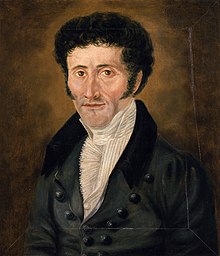
Self-portrait |
|
| Born | Ernst Theodor Wilhelm Hoffmann 24 January 1776 Königsberg, Kingdom of Prussia, Holy Roman Empire |
| Died | 25 June 1822 (aged 46) Berlin, Kingdom of Prussia, German Confederation |
| Pen name | E. T. A. Hoffmann |
| Occupation | Jurist, author, composer, music critic, artist |
| Period | 1809–1822 |
| Genre | Fantasy |
| Literary movement | Romanticism |
| Signature | |
 |
Ernst Theodor Amadeus Hoffmann (born Ernst Theodor Wilhelm Hoffmann; 24 January 1776 – 25 June 1822) was a German Romantic author of fantasy and Gothic horror, a jurist, composer, music critic and artist.[1][2][3] His stories form the basis of Jacques Offenbach’s opera The Tales of Hoffmann, in which Hoffmann appears (heavily fictionalized) as the hero. He is also the author of the novella The Nutcracker and the Mouse King, on which Pyotr Ilyich Tchaikovsky’s ballet The Nutcracker is based. The ballet Coppélia is based on two other stories that Hoffmann wrote, while Schumann’s Kreisleriana[4] is based on Hoffmann’s character Johannes Kreisler.
Hoffmann’s stories highly influenced 19th-century literature, and he is one of the major authors of the Romantic movement.
Life[edit]
Youth[edit]
Hoffmann’s ancestors, both maternal and paternal, were jurists.[5] His father, Christoph Ludwig Hoffmann (1736–97), was a barrister in Königsberg, Prussia (now Kaliningrad, Russia), as well as a poet and amateur musician who played the viola da gamba. In 1767 he married his cousin, Lovisa Albertina Doerffer (1748–96). Ernst Theodor Wilhelm, born on 24 January 1776, was the youngest of three children, of whom the second died in infancy.
When his parents separated in 1778, his father went to Insterburg (now Chernyakhovsk) with his elder son, Johann Ludwig Hoffmann (1768–1822), while Hoffmann’s mother stayed in Königsberg with her relatives: two aunts, Johanna Sophie Doerffer (1745–1803) and Charlotte Wilhelmine Doerffer (c. 1754–79) and their brother, Otto Wilhelm Doerffer (1741–1811), who were all unmarried. The trio raised the youngster.
The household, dominated by the uncle (whom Ernst nicknamed O Weh—»Oh dear!»—in a play on his initials «O.W.»), was pietistic and uncongenial. Hoffmann was to regret his estrangement from his father. Nevertheless, he remembered his aunts with great affection, especially the younger, Charlotte, whom he nicknamed Tante Füßchen («Aunt Littlefeet»). Although she died when he was only three years old, he treasured her memory (a character in Hoffmann’s Lebensansichten des Katers Murr is named after her) and embroidered stories about her to such an extent that later biographers sometimes assumed her to be imaginary, until proof of her existence was found after World War II.[6]
Between 1781 and 1792 he attended the Lutheran school or Burgschule, where he made good progress in classics. He was taught drawing by one Saemann, and counterpoint by a Polish organist named Podbileski, who was to be the prototype of Abraham Liscot in Kater Murr.[citation needed] Ernst showed great talent for piano-playing, and busied himself with writing and drawing. The provincial setting was not, however, conducive to technical progress, and despite his many-sided talents he remained rather ignorant of both classical forms and of the new artistic ideas that were developing in Germany. He had, however, read Schiller, Goethe, Swift, Sterne, Rousseau and Jean Paul, and wrote part of a novel titled Der Geheimnisvolle.
Around 1787 he became friends with Theodor Gottlieb von Hippel the Younger (1775–1843), the son of a pastor, and nephew of Theodor Gottlieb von Hippel the Elder, the well-known writer friend of Immanuel Kant. During 1792, both attended some of Kant’s lectures at the University of Königsberg. Their friendship, although often tested by an increasing social difference, was to be lifelong.
In 1794, Hoffmann became enamored of Dora Hatt, a married woman to whom he had given music lessons. She was ten years older, and gave birth to her sixth child in 1795.[7] In February 1796, her family protested against his attentions and, with his hesitant consent, asked another of his uncles to arrange employment for him in Glogau (Głogów), Prussian Silesia.[8]
The provinces[edit]
From 1796, Hoffmann obtained employment as a clerk for his uncle, Johann Ludwig Doerffer, who lived in Glogau with his daughter Minna. After passing further examinations he visited Dresden, where he was amazed by the paintings in the gallery, particularly those of Correggio and Raphael. During the summer of 1798, his uncle was promoted to a court in Berlin, and the three of them moved there in August—Hoffmann’s first residence in a large city. It was there that Hoffmann first attempted to promote himself as a composer, writing an operetta called Die Maske and sending a copy to Queen Luise of Prussia. The official reply advised to him to write to the director of the Royal Theatre, a man named Iffland. By the time the latter responded, Hoffmann had passed his third round of examinations and had already left for Posen (Poznań) in South Prussia in the company of his old friend Hippel, with a brief stop in Dresden to show him the gallery.
From June 1800 to 1803, he worked in Prussian provinces in the area of Greater Poland and Masovia. This was the first time he had lived without supervision by members of his family, and he started to become «what school principals, parsons, uncles, and aunts call dissolute.»[9]
His first job, at Posen, was endangered after Carnival on Shrove Tuesday 1802, when caricatures of military officers were distributed at a ball. It was immediately deduced who had drawn them, and complaints were made to authorities in Berlin, who were reluctant to punish the promising young official. The problem was solved by «promoting» Hoffmann to Płock in New East Prussia, the former capital of Poland (1079–1138), where administrative offices were relocated from Thorn (Toruń). He visited the place to arrange lodging, before returning to Posen where he married Mischa (Maria or Marianna Thekla Michalina Rorer, whose Polish surname was Trzcińska). They moved to Płock in August 1802.
Hoffmann despaired because of his exile, and drew caricatures of himself drowning in mud alongside ragged villagers. He did make use, however, of his isolation, by writing and composing. He started a diary on 1 October 1803. An essay on the theatre was published in Kotzebue’s periodical, Die Freimüthige, and he entered a competition in the same magazine to write a play. Hoffmann’s was called Der Preis («The Prize»), and was itself about a competition to write a play. There were fourteen entries, but none was judged worthy of the award: 100 Friedrichs d’or. Nevertheless, his entry was singled out for praise.[10] This was one of the few good times of a sad period of his life, which saw the deaths of his uncle J. L. Hoffmann in Berlin, his Aunt Sophie, and Dora Hatt in Königsberg.
At the beginning of 1804, he obtained a post at Warsaw.[11] On his way there, he passed through his hometown and met one of Dora Hatt’s daughters. He was never to return to Königsberg.
Warsaw[edit]
Hoffmann assimilated well with Polish society; the years spent in Prussian Poland he recognized as the happiest of his life. In Warsaw he found the same atmosphere he had enjoyed in Berlin, renewing his friendship with Zacharias Werner, and meeting his future biographer, a neighbour and fellow jurist called Julius Eduard Itzig (who changed his name to Hitzig after his baptism). Itzig had been a member of the Berlin literary group called the Nordstern, or «North Star», and he gave Hoffmann the works of Novalis, Ludwig Tieck, Achim von Arnim, Clemens Brentano, Gotthilf Heinrich von Schubert, Carlo Gozzi and Calderón. These relatively late introductions marked his work profoundly.
He moved in the circles of August Wilhelm Schlegel, Adelbert von Chamisso, Friedrich de la Motte Fouqué, Rahel Levin and David Ferdinand Koreff.
But Hoffmann’s fortunate position was not to last: on 28 November 1806, during the War of the Fourth Coalition, Napoleon Bonaparte’s troops captured Warsaw, and the Prussian bureaucrats lost their jobs. They divided the contents of the treasury between them and fled. In January 1807, Hoffmann’s wife and two-year-old daughter Cäcilia returned to Posen, while he pondered whether to move to Vienna or go back to Berlin. A delay of six months was caused by severe illness. Eventually the French authorities demanded that all former officials swear allegiance or leave the country. As they refused to grant Hoffmann a passport to Vienna, he was forced to return to Berlin.
He visited his family in Posen before arriving in Berlin on 18 June 1807, hoping to further his career there as an artist and writer.
Berlin and Bamberg[edit]
The next fifteen months were some of the worst in Hoffmann’s life.
The city of Berlin was also occupied by Napoleon’s troops. Obtaining only meagre allowances, he had frequent recourse to his friends, constantly borrowing money and still going hungry for days at a time; he learned that his daughter had died. Nevertheless, he managed to compose his Six Canticles for a cappella choir: one of his best compositions, which he would later attribute to Kreisler in Lebensansichten des Katers Murr.
Hoffmann’s portrait of Kapellmeister Kreisler
On 1 September 1808 he arrived with his wife in Bamberg, where he began a job as theatre manager. The director, Count Soden, left almost immediately for Würzburg, leaving a man named Heinrich Cuno in charge. Hoffmann was unable to improve standards of performance, and his efforts caused intrigues against him which resulted in him losing his job to Cuno. He began work as music critic for the Allgemeine musikalische Zeitung, a newspaper in Leipzig, and his articles on Beethoven were especially well received, and highly regarded by the composer himself. It was in its pages that the «Kapellmeister Johannes Kreisler» character made his first appearance.
Hoffmann’s breakthrough came in 1809, with the publication of Ritter Gluck, a story about a man who meets, or believes he has met, the composer Christoph Willibald Gluck (1714–87) more than twenty years after the latter’s death. The theme alludes to the work of Jean Paul, who invented the term Doppelgänger the previous decade, and continued to exact a powerful influence over Hoffmann, becoming one of his earliest admirers. With this publication, Hoffmann began to use the pseudonym E. T. A. Hoffmann, telling people that the «A» stood for Amadeus, in homage to the composer Wolfgang Amadeus Mozart (1756–91). However, he continued to use Wilhelm in official documents throughout his life, and the initials E. T. W. also appear on his gravestone.
The next year, he was employed at the Bamberg Theatre as stagehand, decorator, and playwright, while also giving private music lessons.
He became so enamored of a young singing student, Julia Marc, that his feelings were obvious whenever they were together, and Julia’s mother quickly found her a more suitable match. When Joseph Seconda offered Hoffmann a position as musical director for his opera company (then performing in Dresden), he accepted, leaving on 21 April 1813.
Dresden and Leipzig[edit]
Prussia had declared war against France on 16 March during the War of the Sixth Coalition, and their journey was fraught with difficulties. They arrived on the 25th, only to find that Seconda was in Leipzig; on the 26th, they sent a letter pleading for temporary funds. That same day Hoffmann was surprised to meet Hippel, whom he had not seen for nine years.
The situation deteriorated, and in early May Hoffmann tried in vain to find transport to Leipzig. On 8 May, the bridges were destroyed, and his family were marooned in the city. During the day, Hoffmann would roam, watching the fighting with curiosity. Finally, on 20 May, they left for Leipzig, only to be involved in an accident which killed one of the passengers in their coach and injured his wife.
They arrived on 23 May, and Hoffmann started work with Seconda’s orchestra, which he found to be of the best quality. On 4 June an armistice began, which allowed the company to return to Dresden. But on 22 August, after the end of the armistice, the family was forced to relocate from their pleasant house in the suburbs into the town, and during the next few days the Battle of Dresden raged. The city was bombarded; many people were killed by bombs directly in front of him. After the main battle was over, he visited the gory battlefield. His account can be found in Vision auf dem Schlachtfeld bei Dresden. After a long period of continued disturbance, the town surrendered on 11 November, and on 9 December the company travelled to Leipzig.
On 25 February, Hoffmann quarrelled with Seconda, and the next day he was given notice of twelve weeks. When asked to accompany them on their journey to Dresden in April, he refused, and they left without him. But during July his friend Hippel visited, and soon he found himself being guided back into his old career as a jurist.
Berlin[edit]
Grave of E. T. A. Hoffmann. Translated, the inscription reads: E. T. W. Hoffmann, born on 24 January 1776, in Königsberg, died on 25 June 1822, in Berlin, Councillor of the Court of Justice, excellent in his office, as a poet, as a musician, as a painter, dedicated by his friends.
At the end of September 1814, in the wake of Napoleon’s defeat, Hoffmann returned to Berlin and succeeded in regaining a job at the Kammergericht, the chamber court. His opera Undine was performed by the Berlin Theatre. Its successful run came to an end only after a fire on the night of the 25th performance. Magazines clamoured for his contributions, and after a while his standards started to decline. Nevertheless, many masterpieces date from this time.
During the period from 1819, Hoffmann was involved with legal disputes, while fighting ill health. Alcohol abuse and syphilis eventually caused weakening of his limbs during 1821, and paralysis from the beginning of 1822. His last works were dictated to his wife or to a secretary.
Prince Metternich’s anti-liberal programs began to put Hoffmann in situations that tested his conscience. Thousands of people were accused of treason for having certain political opinions,
and university professors were monitored during their lectures.
King Frederick William III of Prussia appointed an Immediate Commission for the investigation of political dissidence; when he found its observance of the rule of law too frustrating, he established a Ministerial Commission to interfere with its processes. The latter was greatly influenced by Commissioner Kamptz. During the trial of «Turnvater» Jahn, the founder of the gymnastics association movement, Hoffmann found himself annoying Kamptz, and became a political target. When Hoffmann caricatured Kamptz in a story (Meister Floh), Kamptz began legal proceedings. These ended when Hoffmann’s illness was found to be life-threatening. The King asked for a reprimand only, but no action was ever taken. Eventually Meister Floh was published with the offending passages removed.
Hoffmann died of syphilis in Berlin on 25 June 1822 at the age of 46. His grave is preserved in the Protestant Friedhof III der Jerusalems- und Neuen Kirchengemeinde (Cemetery No. III of the congregations of Jerusalem Church and New Church) in Berlin-Kreuzberg, south of Hallesches Tor at the underground station Mehringdamm.
Works[edit]
Literary[edit]
Four volume set of Hoffmann’s writings
- Fantasiestücke in Callots Manier (collection of previously published stories, 1814)[12]
- «Ritter Gluck», «Kreisleriana», «Don Juan», «Nachricht von den neuesten Schicksalen des Hundes Berganza»
- «Der Magnetiseur», «Der goldne Topf» (revised in 1819), «Die Abenteuer der Silvesternacht»
- Die Elixiere des Teufels (1815)
- Nachtstücke (1817)
- «Der Sandmann», «Das Gelübde», «Ignaz Denner», «Die Jesuiterkirche in G.»
- «Das Majorat», «Das öde Haus», «Das Sanctus», «Das steinerne Herz»
- Seltsame Leiden eines Theater-Direktors (1819)
- Little Zaches (1819)
- Die Serapionsbrüder (1819)
- «Der Einsiedler Serapion», «Rat Krespel», «Die Fermate», «Der Dichter und der Komponist»
- «Ein Fragment aus dem Leben dreier Freunde», «Der Artushof», «Die Bergwerke zu Falun», «Nußknacker und Mausekönig» (1816)
- «Der Kampf der Sänger», «Eine Spukgeschichte», «Die Automate», «Doge und Dogaresse»
- «Alte und neue Kirchenmusik», «Meister Martin der Küfner und seine Gesellen», «Das fremde Kind»
- «Nachricht aus dem Leben eines bekannten Mannes», «Die Brautwahl», «Der unheimliche Gast»
- «Das Fräulein von Scuderi», «Spielerglück» (1819), «Der Baron von B.»
- «Signor Formica», «Zacharias Werner», «Erscheinungen»
- «Der Zusammenhang der Dinge», «Vampirismus», «Die ästhetische Teegesellschaft», «Die Königsbraut»
- Prinzessin Brambilla (1820)
- Lebensansichten des Katers Murr (1820)
- «Die Irrungen» (1820)
- «Die Geheimnisse» (1821)
- «Die Doppeltgänger» (1821)
- Meister Floh (1822)
- «Des Vetters Eckfenster» (1822)
- Letzte Erzählungen (1825)
Musical[edit]
Vocal music[edit]
- Messa d-moll (1805)
- Trois Canzonettes à 2 et à 3 voix (1807)
- 6 Canzoni per 4 voci alla capella (1808)
- Miserere b-moll (1809)
- In des Irtisch weiße Fluten (Kotzebue), Lied (1811)
- Recitativo ed Aria „Prendi l’acciar ti rendo» (1812)
- Tre Canzonette italiane (1812); 6 Duettini italiani (1812)
- Nachtgesang, Türkische Musik, Jägerlied, Katzburschenlied für Männerchor (1819–21)
Works for stage[edit]
- Die Maske (libretto by Hoffmann), Singspiel (1799)
- Die lustigen Musikanten (libretto: Clemens Brentano), Singspiel (1804)
- Incidental music to Zacharias Werner’s tragedy Das Kreuz an der Ostsee (1805)
- Liebe und Eifersucht (libretto by Hoffmann after Calderón, translated by August Wilhelm Schlegel) (1807)
- Arlequin, ballet (1808)
- Der Trank der Unsterblichkeit (libretto: Julius von Soden), romantic opera (1808)
- Wiedersehn! (libretto by Hoffmann), prologue (1809)
- Dirna (libretto: Julius von Soden), melodrama (1809)
- Incidental music to Julius von Soden’s drama Julius Sabinus (1810)
- Saul, König von Israel (libretto: Joseph von Seyfried), melodrama (1811)
- Aurora (libretto: Franz von Holbein), heroic opera (1812)
- Undine (libretto: Friedrich de la Motte Fouqué), Zauberoper (1816)
- Der Liebhaber nach dem Tode (unfinished)
Instrumental[edit]
- Rondo für Klavier (1794/95)
- Ouvertura. Musica per la chiesa d-moll (1801)
- Klaviersonaten: A-Dur, f-moll, F-Dur, f-moll, cis-moll (1805–1808)
- Große Fantasie für Klavier (1806)
- Sinfonie Es-Dur (1806)
- Harfenquintett c-moll (1807)
- Grand Trio E-Dur (1809)
- Walzer zum Karolinentag (1812)
- Teutschlands Triumph in der Schlacht bei Leipzig, (by «Arnulph Vollweiler», 1814; lost)
- Serapions-Walzer (1818–1821)
Assessment[edit]
Statue of «E. T. A. Hoffmann and his cat» in Bamberg
Hoffmann is one of the best-known representatives of German Romanticism, and a pioneer of the fantasy genre, with a taste for the macabre combined with realism that influenced such authors as Edgar Allan Poe (1809–1849), Nikolai Gogol[13][14] (1809–1852), Charles Dickens (1812–1870), Charles Baudelaire (1821–1867), George MacDonald (1824–1905),[15] Fyodor Dostoevsky (1821–1881), Vernon Lee (1856–1935),[16] Franz Kafka (1883–1924) and Alfred Hitchcock (1899–1980). Hoffmann’s story Das Fräulein von Scuderi is sometimes cited as the first detective story and a direct influence on Poe’s «The Murders in the Rue Morgue»;[17] Characters from it also appear in the opera Cardillac by Paul Hindemith.
The twentieth-century Russian literary theorist Mikhail Bakhtin characterised Hoffmann’s works as Menippea, essentially satirical and self-parodying in form, thus including him in a tradition that includes Cervantes, Diderot and Voltaire.
Robert Schumann’s piano suite Kreisleriana (1838) takes its title from one of Hoffmann’s books (and according to Charles Rosen’s The Romantic Generation, is possibly also inspired by «The Life and Opinions of Tomcat Murr», in which Kreisler appears).[4] Jacques Offenbach’s masterwork, the opera Les contes d’Hoffmann («The Tales of Hoffmann», 1881), is based on the stories, principally «Der Sandmann» («The Sandman», 1816), «Rat Krespel» («Councillor Krespel», 1818), and «Das verlorene Spiegelbild» («The Lost Reflection») from Die Abenteuer der Silvester-Nacht (The Adventures of New Year’s Eve, 1814). Klein Zaches genannt Zinnober (Little Zaches called Cinnabar, 1819) inspired an aria as well as the operetta Le Roi Carotte, 1872). Pyotr Ilyich Tchaikovsky’s ballet The Nutcracker (1892) is based on «The Nutcracker and the Mouse King», and the ballet Coppélia, with music by Delibes, is based on two eerie Hoffmann stories.
Hoffmann also influenced 19th-century musical opinion directly through his music criticism. His reviews of Beethoven’s Symphony No. 5 in C minor, Op. 67 (1808) and other important works set new literary standards for writing about music, and encouraged later writers to consider music as «the most Romantic of all the arts.»[18] Hoffmann’s reviews were first collected for modern readers by Friedrich Schnapp, ed., in E.T.A. Hoffmann: Schriften zur Musik; Nachlese (1963) and have been made available in an English translation in E.T.A. Hoffmann’s Writings on Music, Collected in a Single Volume (2004).
Hoffmann’s drawing of himself, riding on Tomcat Murr and fighting «Prussian bureaucracy»
Hoffmann strove for artistic polymathy. He created far more in his works than mere political commentary achieved through satire. His masterpiece novel Lebensansichten des Katers Murr (The Life and Opinions of Tomcat Murr, 1819–1821) deals with such issues as the aesthetic status of true artistry and the modes of self-transcendence that accompany any genuine endeavour to create. Hoffmann’s portrayal of the character Kreisler (a genius musician) is wittily counterpointed with the character of the tomcat Murr – a virtuoso illustration of artistic pretentiousness that many of Hoffmann’s contemporaries found offensive and subversive of Romantic ideals.
Hoffmann’s literature indicates the failings of many so-called artists to differentiate between the superficial and the authentic aspects of such Romantic ideals. The self-conscious effort to impress must, according to Hoffmann, be divorced from the self-aware effort to create. This essential duality in Kater Murr is conveyed structurally through a discursive ‘splicing together’ of two biographical narratives.
Science fiction[edit]
While disagreeing with E. F. Bleiler’s claim that Hoffmann was «one of the two or three greatest writers of fantasy», Algis Budrys of Galaxy Science Fiction said that he «did lay down the groundwork for some of our most enduring themes».[19]
Historian Martin Willis argues that Hoffmann’s impact on science fiction has been overlooked, saying «his work reveals a writer dynamically involved in the important scientific debates of the late eighteenth and early nineteenth centuries.» Willis points out that Hoffmann’s work is contemporary with Frankenstein (1818) and with «the heated debates and the relationship between the new empirical science and the older forms of natural philosophy that held sway throughout the eighteenth century.» His «interest in the machine culture of his time is well represented in his short stories, of which the critically renowned The Sandman (1816) and Automata (1814) are the best examples. …Hoffmann’s work makes a considerable contribution to our understanding of the emergence of scientific knowledge in the early years of the nineteenth century and to the conflict between science and magic, centred mainly on the ‘truths’ available to the advocates of either practice. …Hoffmann’s balancing of mesmerism, mechanics, and magic reflects the difficulty in categorizing scientific knowledge in the early nineteenth century.»[20]
In popular culture[edit]
- Robertson Davies invokes Hoffmann as a character (with the pet name of ‘ETAH’) trapped in Limbo, in his novel The Lyre of Orpheus (1988).
- Alexandre Dumas, père translated The Nutcracker into French, which aided in making the tale popular and widespread.
- The exotic and supernatural elements in the storyline of Ingmar Bergman’s 1982 film Fanny and Alexander derive largely from the stories of Hoffmann.[21]
- Freud gives an extensive psychoanalytic analysis of Hoffmann’s «The Sandman» in his 1919 essay Das Unheimliche.[citation needed]
- Coppelius is a German classical metal band whose name is taken from a character in Hoffmann’s «The Sandman». The band’s 2010 album Zinnober includes a track titled «Klein Zaches».[22][citation needed]
- The Russian show Puppets was cancelled by government officials after an episode in which Vladimir Putin was portrayed as Hoffmann’s Klein Zaches.[23][1][24]
See also[edit]
- The Tales of Hoffmann for Offenbach’s opera.
- The Tales of Hoffmann for the film
- Gofmaniada, a Russian puppet-animated feature film about Hoffmann and several of his stories.
References[edit]
- ^ a b Penrith Goff, «E.T.A. Hoffmann» in E. F. Bleiler, Supernatural Fiction Writers: Fantasy and Horror. New York: Scribner’s, 1985. pp. 111–120. ISBN 0-684-17808-7
- ^ Mike Ashley, «Hoffmann, E(rnst) T(heodor) A(madeus) «, in St. James Guide to Horror, Ghost, and Gothic Writers, ed. David Pringle. Detroit: St. James Press/Gale, 1998. ISBN 9781558622067 (pp. 668-69).
- ^ «Ludwig Tieck, Heinrich von Kleist, and E. T. A. Hoffmann also profoundly influenced the development of European Gothic horror in the nineteenth century….» Heide Crawford, The Origins of the Literary Vampire. Lanham : Rowman & Littlefield, 2016. ISBN 9781442266742 (p. xiii).
- ^ a b Schumann, Robert (2004). Herttrich, Ernst (ed.). Kreisleriana (PDF) (in German, English, and French). G. Henle Verlag. pp. III.
- ^ Jaffé 1978, p. 13.
- ^ Friedrich Schnapp. «Hoffmanns Verwandte aus der Familie Doerffer in Königsberger Kirchenbüchern der Jahre 1740–1811.» Mitteilungen der E. T. A. Hoffmann-Gesellschaft. 23 (1977), 1–11.
- ^ Zipes, Jack (2007) [1816]. «The ‘Merry’ Dance of the Nutcracker: Discovering the World through Fairy Tales». Nutcracker & Mouse King & The Tale of the Nutcracker. Penguin Classics. ISBN 978-0143104834. Retrieved 7 July 2019.
He began writing novels and musical compositions as a young man and had his first love affair in 1794 with Cora (Dora) Hatt, a woman ten years older
- ^ Rüdiger Safranski. E. T. A. Hoffmann: Das Leben eines skeptischen Phantasten. Carl Hanser, Munich, 1984. ISBN 3-446-13822-6
Gerhard R. Kaiser. E. T. A. Hoffmann. J. B. Metzlersche, Stuttgart, 1988. ISBN 3-476-10243-2 - ^ Hoffmann, E. T. A. (1977). Sahlin, Johanna C. (ed.). Selected Letters of E. T. A. Hoffmann. Translated by Sahlin, Johanna C. University of Chicago Press. p. 94. ISBN 0-226-34790-7.
- ^ Die Freimüthige, 11 February 1804. Volume II, no. 6, pages xxi–xxiv.
- ^ Jaffé 1978, p. 15.
- ^ «Fantasy pieces in the manner of Jacques Callot»
- ^ Krys Svitlana, «Intertextual Parallels Between Gogol’ and Hoffmann: A Case Study of Vij and The Devil’s Elixirs.» Canadian-American Slavic Studies (CASS) 47.1 (2013): 1-20. (20 pages)
- ^ Krys Svitlana, «Allusions to Hoffmann in Gogol’s Ukrainian Horror Stories from the Dikan’ka Collection.» Canadian Slavonic Papers: Special Issue, devoted to the 200th anniversary of Nikolai Gogol’s birth (1809–1852) 51.2-3 (June–September 2009): 243-266. (23 pages)
- ^ Greville MacDonald, George MacDonald and His Wife London: Allen and Unwin, 1924 (p. 297-8).
- ^ «Another major influence for Lee is unmistakably E.T.A. Hoffmann’s Der Sandmann…» Christa Zorn, Vernon Lee : aesthetics, history, and the Victorian female intellectual. Athens : Ohio University Press, 2003. ISBN 0821414976 (p. 142).
- ^ The Seven Basic Plots, Christopher Booker, Continuum, 2004, page 507
- ^ See also Fausto Cercignani, E. T. A. Hoffmann, Italien und die romantische Auffassung der Musik, in S. M. Moraldo (ed.), Das Land der Sehnsucht. E. T. A. Hoffmann und Italien, Heidelberg, Winter, 2002, S. 191–201.
- ^ Budrys, Algis (July 1968). «Galaxy Bookshelf». Galaxy Science Fiction. pp. 161–167.
- ^ Martin Willis (2006). Mesmerists, Monsters, and Machines: Science Fiction and the Cultures of Science in the Nineteenth Century. Kent, Ohio: Kent State University Press. pp. 29–30.
- ^ «Fanny and Alexander». www.ingmarbergman.se. Retrieved 21 June 2020.
- ^ Review of Zinnober, http://www.ice-vajal.com/c/CD/coppelius.htm
- ^ «New Cartoon Show Puts Putin Among Men» http://www.ekaterinburg.com/news/print/news_id-316222.html
- ^ Loiko, Sergei (20 February 2012). «Vladimir Putin is spoofed on the Internet». Los Angeles Times. Retrieved 27 June 2021.
Sources[edit]
- Jaffé, Aniela (1978). Bilder und Symbole aus E. T. A. Hoffmann’s Märchen «Der Goldne Topf» (in German) (2nd ed.). Gerstenberg Verlag Hildesheim.
External links[edit]
German Wikisource has original text related to this article:
- Works by E. T. A. Hoffmann in eBook form at Standard Ebooks
- Works by E. T. A. Hoffmann at Project Gutenberg
- Works by or about E. T. A. Hoffmann at Internet Archive
- Works by E. T. A. Hoffmann at LibriVox (public domain audiobooks)
- Hoffmann’s Life and Opinions of the Tom Cat Murr
- Free scores by E. T. A. Hoffmann in the Choral Public Domain Library (ChoralWiki)
- T. A. Hoffmann’s Fairy Tales
- Compositions of E. T. A. Hoffmann in the digital collection of the Bamberg State Library
- E. T. A. Hoffmann entry in The Encyclopedia of Fantasy
- E. T. A. Hoffmann at the Internet Speculative Fiction Database
- Extensively cross-indexed bibliography of Hoffmann’s works

